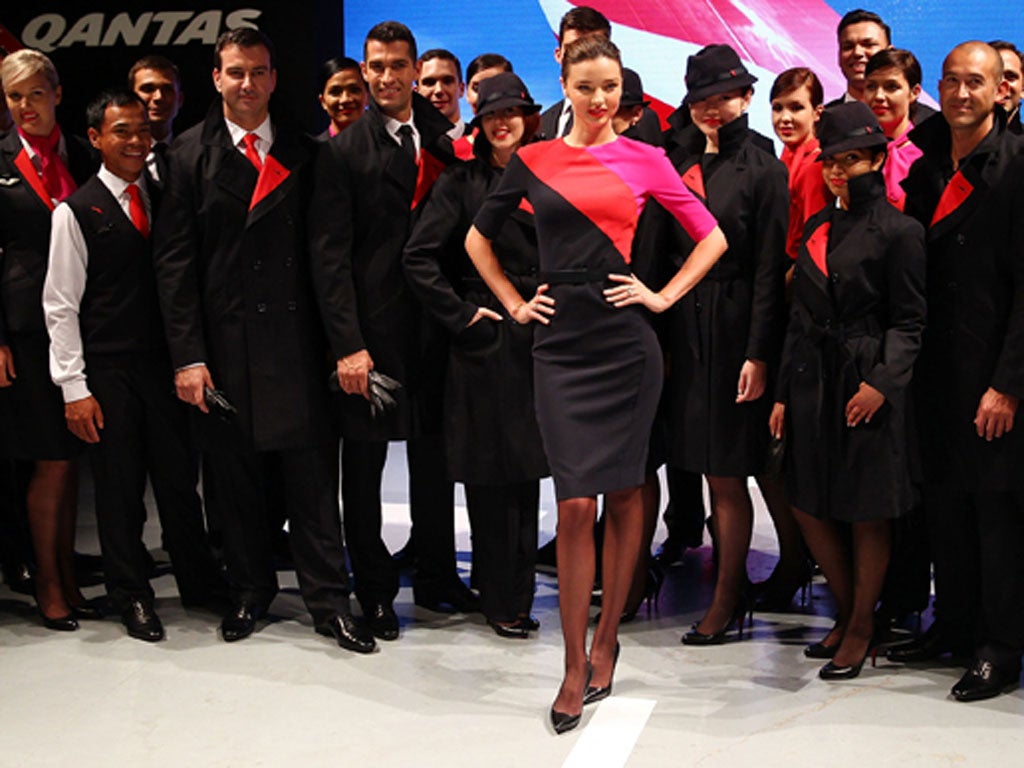Male and female flight attendants don't do different jobs, so why make women wear a sexy uniform?
It seems women are being sent two steps back in the constant battle to be treated as equals at work

Fashion is obliged to constantly reinvent itself, so that everything eventually comes back in vogue, and it seems the same can be said of good old-fashioned misogyny. If you thought the era of the glamorous “trolley dolly” was consigned to the annals of sixties and seventies sexism, you should check out the controversial new uniforms that are being rolled out to Qantas cabin crew from today.
Spot the glaringly obvious difference between the male and the female version of the outfit, designed by Australian Michael Grant. The women’s uniform, as modelled by supermodel Miranda Kerr, is a form fitting shift dress with a vibrant splash of fuchsia pink, more suited to a dinner date than for dishing up plane food and placing hand luggage in the overhead compartments. The male version, meanwhile, is a rather more muted and far more practical trouser suit. Qantas, it seems, are intent on making sure women take the obligatory two steps back in the constant battle to be treated as equals at work.
Now, please don’t misunderstand me. I have nothing against a shift dress per se. In fact, I own at least three, and have worn them in the office. What I object to is the idea of men and women having two such contrasting uniforms imposed upon them, as though they perform totally different functions at work. The message it sends out is that the job of the stewardess is to be sexy, to get her wriggle on in her pencil dress and give those men in business class something more interesting to look at than the FT, whilst the job of her male counterpart is to carry out practical duties in an efficient manner.
The new outfits have received a predictably luke-warm reception from staff. Flight attendants, like the rest of us, come in various shapes and sizes and range in age from their twenties to their sixties. Whilst those who are body-confident might be happy enough to wear a tight dress, what about those women who are conscious of their lumps and bumps? The shift was made iconic by Audrey Hepburn – a self-confessed anorexia sufferer – in Breakfast at Tiffany’s, but what is the average woman to do when obliged to wear such a garment? Crack out the Spanx pants, presumably, a horribly uncomfortable prospect on a long-haul flight. Hell, why not bring back the girdle, nay, even the corset, and really truss up these women like turkeys? Anyone who has ever flown understands the need for comfortable clothing on a plane. On a recent trans-Atlantic flight, I swelled larger than my normal size, and it definitely wasn’t solely down to the gin and tonic. A tight dress and heels is bound to be uncomfortable, restrictive and impractical on board, even for those blessed with the “right” kinds of figure for such an ensemble.
As one flight attendant pointed out, the dress looked fabulous when worn by Victoria’s Secret model Miranda Kerr, “But sadly, we don’t all look like her.” No indeed, so what would Qantas suggest to the women who have never learned Victoria’s Secret to looking amazing? Exercise more, eat less, put yourself on the rack and stretch yourself out until you too have a peculiarly long torso? Meanwhile, the male flight attendants can happily conceal their beer bellies and love handles under their more forgiving uniforms.
This may seem like a lot of fuss over a dress, but it’s really about what the dress represents that irks me. It’s about men telling women what they should and should not wear, from warning us not to wear short skirts (in case we cause rape) to the law firm, Clifford Chance, issuing a ludicrous memo to female solicitors instructing them in the dark arts of deportment. Men, meanwhile, can just throw on a suit and tie and they’re good to go in most situations.
Of course, being female also means we can have far more fun. We have many more choices open to us when it comes to clothes and personal presentation, as transvestites and drag queens envy. Women can wear trouser suits but men cannot normally wear skirts – although there is still resistance to women wearing trousers in some arenas, such as on American television news shows, where the female hosts almost always wear skirts. When it’s our own choice to look feminine and sexy, this is one thing. It is quite another for it to be a job requirement, unless we are working in the skin industries.
There's a popular male fantasy of the sexy air hostess, one who might just join the Mile High club with you, as in a very cheesy porno. This unwritten expectation of sexiness, subservience and femininity is one of the reasons why there are so few female pilots on any airline, and why the idea of a “woman driver” would still cause some passengers to panic. Whatever their reasoning, in the long haul to equality in the workplace, Qantas clearly still has miles to go.
A spokesperson for Qantas said earlier in the week that the uniforms had been trialled by 75 members of staff and that "the feedback we've had from staff on the new uniform has been overwhelmingly positive."

Join our commenting forum
Join thought-provoking conversations, follow other Independent readers and see their replies